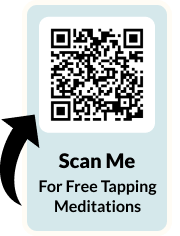Addiction is a challenging issue that affects millions of people worldwide. Whether you’re struggling with cigarettes, sugar cravings, or other addictions, finding effective tools for recovery can be difficult.
One powerful technique that has shown promise in addiction support is Emotional Freedom Techniques (EFT), also known as Tapping. Over the past several decades, I’ve personally witnessed many people break free from a variety of different addictions with the help of Tapping.
In this article, we’ll explore how to use Tapping for addictions and cravings, dive into the scientific research that backs this practice up, and hear success stories from real people who’ve put this technique to the test.
What is Tapping and how does it work for addiction?
Tapping is a mind-body approach that combines the principles of modern psychology with ancient Chinese acupressure.
The technique involves gently tapping on specific points on the body while focusing on the issue at hand – such as stress, a strong emotion, a physical symptom, or a craving, for example. That process sends a calming signal to the brain, allowing you to feel more relaxed and in control.
Tapping works on many levels to support recovery from addiction and cravings:
1. Reduces stress
Tapping regulates the nervous system and calms the fight-or-flight stress response (even lowering levels of the stress hormone cortisol), helping you to release stress and bring your mind and body into a calmer state.[1,2]
This is important, because stress and addiction are tightly linked.
Research shows that the more stressed we are and the less well we manage that stress, the more likely we are to use substances. People with addiction and substance abuse disorders also often report that they turn to their substance of choice to “self-medicate” psychological distress and mental health issues.[3]
Researchers believe that when we can better manage our response to stress, it can help us to prevent cravings, substance use, and risk of relapse.[4]
With the help of Tapping, we can learn to respond to challenges from a place of greater balance and calm, potentially disrupting unhelpful patterns that may contribute to addictions or cravings.
2. Release unresolved emotional issues
Tapping is an excellent tool for addressing unresolved emotional issues that is often at the root of addiction.
I’ve worked with many people around addictions and cravings using Tapping. With this kind of work, we usually start on the surface to address the physical craving, but then we almost always dig deeper to the feelings that are buried underneath whatever the substance of choice may be (whether it is alcohol, sugar, or cigarettes).
Through Tapping, we are able to find the unresolved emotional issues that are truly at the root of the issue. This paves the way for long-term resolution of addictive behaviors, because we have actually gone underneath the surface to the deeper issues at hand.
Research confirms that Tapping can help people address difficult experiences from early life that may play a role in substance use.[3]
3. Provides a healthy behavior replacement
Whenever a craving hits, individuals can turn to the Tapping technique as a positive habit to take the place of their old behaviors.
For example, if you’re trying to avoid alcohol and find yourself tempted to drink a glass of wine with your dinner, you could excuse yourself briefly to do a few rounds of Tapping instead. Or, if you always crave a cigarette on your lunch break to help release stress, you could practice Tapping on that break instead as a healthier, and more effective, alternative.
Tapping is a great way to interrupt old patterns so we can release the old habits that have been causing harm and replace them with new, more empowering ones.
How to use Tapping for addiction and cravings
Tapping can be used in the moment when experiencing a craving or urge, and it can also be used on an ongoing basis to release stress, process emotions, and explore the deeper root of addictive behaviors.
If you want to get started right away with a few minutes of Tapping, try these 7 simple steps to release a craving:
- Identify the craving or addictive urge you’re currently experiencing.
- Rate the intensity of the craving or urge on a scale from 0-10, with 10 being the most intense.
- Create a setup statement that acknowledges the problem and accepts yourself, such as: “Even though I’m craving a cigarette right now, I deeply and completely accept myself.”
- Tap on the side of your hand while repeating your setup statement three times.
- Tap through the following Tapping points while focusing on your craving or the feelings you are having related to the craving:
- Eyebrow
- Side of the eye
- Under the eye
- Under the nose
- Under the mouth
- Collarbone
- Under the arm
- Top of the head
- Rate the intensity of the craving or urge again on a scale from 0-10.
- Repeat the previous steps as necessary until your intensity goes down and you feel more calm and grounded.
For a complete guide on how to use Tapping and how to apply it to various issues, check out this comprehensive how-to guide.
And be sure to head to The Tapping Solution App to find guided meditations like these:






What does the research say on Tapping for addiction?
Scientific studies have shown that Tapping can be a valuable tool in addiction treatment.
One study published in the Journal of Scientific Research & Reports in 2013 by Dawson Church and Audrey Brooks demonstrated the effectiveness of Tapping in individuals with addiction.
The study involved 39 participants at a weekend workshop. Participants who practiced Tapping reported significant reductions in distress and psychological symptoms such as anxiety and depression, both immediately following the workshop and at a 90-day follow-up.
The participants in the study were specifically instructed on how to use EFT Tapping to address adverse childhood experiences – which is one of the reasons Tapping may have proved to be so helpful in the study.
From the data, the researchers concluded that “EFT may be an effective adjunct to addiction treatment.”[3]
Common, traditional treatments for addiction often don’t address the whole picture. But this research suggests that Tapping can offer a more holistic approach to addiction, addressing both the emotional and physical aspects involved.
To learn more, read this article on how Tapping proves an effective addition to addiction treatment.
Success stories of using Tapping for addiction
Let’s hear from a few real people who have had incredible results with the help of Tapping to overcome addictions and cravings:
“I used tapping and it was fantastic. There were no withdrawals and it was like I had never smoked, quite amazing. Couldn’t believe it. After 45 years of smoking and the day before I stopped I was smoking 30 to 50 a day. Love that tapping could do that for me.”
-Elly
“Years of anxiety was kicked to the curb in one day with Tapping and it was also key in my recovery from alcoholism. Tapping literally saved my life!”
-Kelly
“I have been tapping for a number of years now – following ‘The Tapping Solution’ – Jessica Nick and Alex – it works it really works I have lost 50lbs ( without restrictive dieting or crazy workouts) I have completely erased ‘ panic attacks’ and anxiety and overcome addictions to alcohol and painkillers– all this has happened slowly and gently over the past 7 years and I continue to use tapping every day – I love it.”
-Julie
Tips for using Tapping for addiction
Tapping for addiction offers a powerful, accessible tool for managing cravings and supporting long-term, sustainable change. By addressing both the physical and emotional aspects of addiction, Tapping can help you break free from destructive patterns and build a healthier, more balanced life.
Here’s how to make the most of this technique:
- Practice consistently: Use Tapping regularly to calm your system, release strong emotions, and empower your mind and body to let go of old patterns and build new, healthier ones. The more you practice, the more you’ll rewire your brain and support your road to recovery.
- Be patient: Freeing yourself from cravings and addictions is a process that takes time – Tapping can help you on your journey if you are patient and stay committed to the process.
- Seek support when needed: Tapping can be a valuable addition to your recovery toolkit, but it’s not a substitute for professional medical advice or treatment. Always consult with a healthcare provider or addiction specialist when dealing with substance abuse issues and when exploring deeper concerns.
Ready to try Tapping for yourself? Download The Tapping Solution App today for guided Tapping meditations specifically designed to support you on your journey.
Here are a few examples of topics covered in the app:
- Opioid Detox Support – Craving Relief
- Opioid Detox Support – Sleep Programming
- Overcome Cigarette Cravings & Quitting Smoking
- Cravings Buster: Alcohol
- Cravings Buster: General Cravings Quick Tap
- Cravings Buster: Sugar



Until next time… Keep Tapping!
Nick Ortner
References
- Church D, Yount G, Brooks AJ. The effect of emotional freedom techniques on stress biochemistry: a randomized controlled trial. J Nerv Ment Dis. 2012;200(10):891-896.
- Stapleton P, Crighton G, Sabot D, O’Neill HM. Reexamining the effect of emotional freedom techniques on stress biochemistry: A randomized controlled trial. Psychol Trauma. 2020;12(8):869-877.
- Church, D & Brooks, AJ. The Effect of EFT (Emotional Freedom Techniques) On Psychological Symptoms In Addiction Treatment: A Pilot Study. Journal of Scientific Research and Reports. 2013;2(2):315-322.
- alʼAbsi M. Stress and Addiction: When a Robust Stress Response Indicates Resiliency. Psychosom Med. 2018;80(1):2-16. doi:10.1097/PSY.0000000000000520












Connect With Us on Social Media